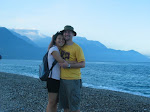
Hi there again
In this post I will give some information about Thessaloniki. Most people that visit Greece will not probably visit Thessaloniki. This is not because it's not a beautiful city but because the Greek tourist board has as a standard policy to promote specific parts of Greece i.e Athens and the islands. Thessaloniki is the second largest city of Greece, with a population of around 1 million (the municipality of Thessaloniki has a population of 363,987) and is the capital of the Macedonia district of northern Greece. It was first established in 316B.C. by
Kassandros and named after his wife, half sister of Alexander the great. Thessaloniki means victory (
niki or
nike-yes even this is a
Greek word!) in Thessaly (in Central Greece). It was a very important city especially during the Roman, Byzantine and Ottoman periods. Apostle Paul visits Thessaloniki in 50AD and writes 2 letters to the Thessalonians. In Byzantine periods it was the second most important city next to
Constantinople and is full with beautiful byzantine art and architecture.
In the 15
th century, during the Ottoman period, Thessaloniki became a haven for Jews exiled from Spain, who were a very important part of the city's culture till they were sent to concentration camps by the Nazi occupation. Thessaloniki became a part of modern Greece in 1912 but was burned in 1917 creating a homeless population of 70,000. If you add to this mixture more than 270,000
Greek refugees that came from Turkey a few years later and you have the making of a social revolution that characterizes the city till this day. The
rebetiko music (or the Greek blues) that
flourished in the city mirrors its colourful past. Originally the music of the underclass it was created in the
tekedes, the Turkish style hash dens, and its lyrics reflect the poverty and
despair of the refugees. If you find all these interesting there is a great book I suggest named "
Salonica: city of ghosts" by Mark
Mazower.
Today Thessaloniki is a lively modern city with lots of energy and life (and too much traffic most of the times!). Apart from the traffic, Thessaloniki is very different from Athens both culturally and in life style. The influence from the east is more pronounced and is easily recognised in the food (will have a separate post for this-best food in the world...and then comes
Taiwanese food) and the relaxed (not so much any more unfortunately) way of life. With two universities both of them in the heart of the city (one of them, Aristotle University has 60,000 students!) has a university town feel. The city is also the site of the Thessaloniki Film Festival in October-November. The women of Thessaloniki have the reputation of being the most chic in Greece (probably spend too much time looking in front of the mirror). As I remember the nightlife of Thessaloniki is exceptional and it
accommodates all the tastes (bars, clubs, many different kinds of music, restaurants etc). Thessaloniki is great for shopping (as Phyllis' sister can confirm...) with many (too many) shops situated in the
centre of the city (most of them really posh). If you like to shop clothes, shoes and
jewellery you will love Thessaloniki. In a totally non biased opinion I think Thessaloniki is the best city in Greece!
That's all for now. In couple of days I will give you some more practical information about the city, especially for places you should visit.







